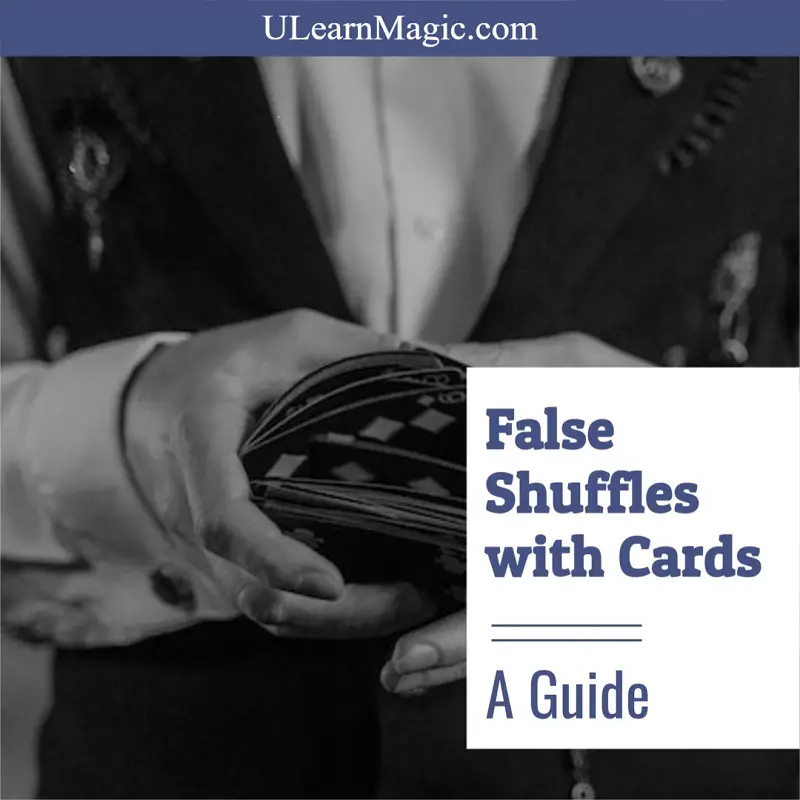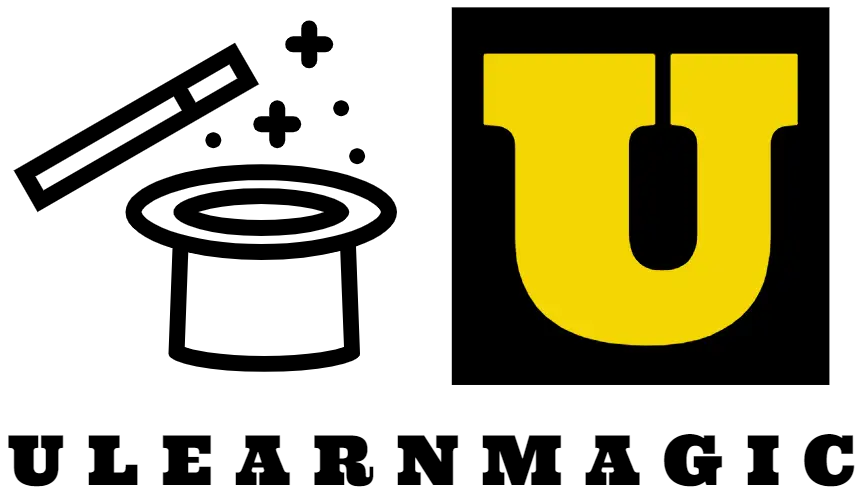
In this post, we will explore what false shuffles are in sleight of hand card magic, what those different false shuffles are, what are the best false shuffles, and more.
What are False Shuffles?
When you false shuffle the cards, you are trying to give the appearance that the cards are being mixed. But the reality is, that one or more cards are not being mixed, and are staying in the same place in the deck.
This is going to be useful for most card tricks. (Note that this is different than false cuts, which are moves that give the appearance of cutting the deck, rather than shuffling the deck. There will be a separate post on false cuts)
The number of cards that you need to stay in the same place, will determine the type of false shuffle that you need to use, as well as the difficulty level of that sleight of hand move. (You can learn about the basics of all moves in card sleight of hand here)
We’ll start with the easiest and work toward the hardest false shuffles. The easiest is just keeping the top (or bottom) card in place.
Retaining the Top (or Bottom) Card
The easiest false shuffle to do in card magic involves just retaining the top card. That is, keeping the top card in place while the rest of the deck is shuffled.
This is useful when you have a controlled card on top of the deck, and you want to keep it on top while making the deck look like it is being completely shuffled.
1) The Overhand Slip Shuffle
The easiest shuffle for me has always been the overhand slip shuffle. You are basically just holding the top card in place with your fingers while shuffling the rest of the deck using an overhand shuffle. Watch the tutorial below to see it in action and learn it.
This one is very easy and hard to mess up. At the same time, it is very convincing, since most of the deck is actually being shuffled.
2) Riffle False Shuffle for Top Card
As shown in the first video, you can also do a riffle shuffle to maintain the top card. All you have to do is allow the top card to fall last and remain on top when you are riffling the two halves together.
3) Overhand Shuffle – Top Card to Bottom Then Back to Top
Another method of retaining the top card is to do a regular overhand shuffle using this method.
Start an overhand shuffle and run the top card off singly by itself into the left hand, then shuffle off the rest of the cards as normal. This will place the top card on the bottom of the deck.
Then, overhand shuffle the pack again. But, as you get to the final cards on the bottom of the deck, run these cards off singly (one at a time). This will place the bottom card (the original top card) back on top of the deck!
For any of these shuffles mentioned, you can just reverse the actions in order to maintain the bottom card instead of retaining the top card.
Retaining the Top Stack
The next level of difficulty in false shuffling a deck of cards involves keeping the top stock (or group of cards) on top.
This is harder than just keeping the top card in place, and involves a different set of shuffles in order to complete this task. Also note, that all of these shuffles will also work to keep only the top card in place, but you could just do the easier shuffles mentioned before.
1) False Riffle Shuffle for Top Stock
You could do a false riffle shuffle as previously shown. Instead of just allowing the top card to fall last when riffling the card together, you would need to allow all of the top stock of cards to fall last and back on top of the deck when shuffling.
When doing multiple cards, this becomes more complicated than when you are just trying to control the top card. This also makes it look less deceptive (since you will have a group of cards falling last instead of just one card). However, it can still work.
This is probably best when you are doing 4 cards or less as your top stock. If you start to get more cards, it will become more and more difficult to use this method, and another method as described below would probably be better.
2) Overhand False Shuffle
This is one of the most common false shuffles for retaining the top stock of cards. There are many, many tutorials on the internet on how to do this, and it is a classic method.
It basically involves overhand shuffling off the top group of cards into the left hand, then running one card on top of this, but in-jogging it back towards you about a quarter of an inch. Then the rest of the cards are shuffled off on top as normal, but back in line with the deck.
This creates an in-jogged card, which can be picked up by the thumb on the right hand, creating a break. Then you can overhand shuffle again, shuffling off until the break, and throwing the remainder on top.
3) Overhand Lift Shuffle
There are different variations of this, especially if you are shuffling the cards face up as opposed to face down.
But essentially, you are overhand shuffling the top stock into the left hand. Then you are picking up secretly with the right hand as you go to shuffle off more cards.
Then when you get to the end of the packet, the secretly held packet, which is the top stock, is thrown back on top of the deck.
4) False Hindu Shuffle for Top Stock
There is a false Hindu shuffle that can be done to retain the top stock of the deck.
This starts by shuffling off the top group of cards into the left hand as normal. It then involves grabbing part of this group with the right thumb and ring finger under the deck of cards and continuing to shuffle off the rest of the deck.
When you are done with the rest of the deck, this group of cards will be left and can be thrown on top, retaining the top stock.
5) Swing Cut Followed By Overhand Shuffle
There is a less common shuffle, which involves first swing cutting the top portion into the left hand.
Immediately both portions are flipped over, and the cards in the right hand are shuffled face up onto the left-hand packet doing an overhand shuffle. This will also preserve the entire top stock that you had cut into your left hand.
This is very good for when you have a large portion of cards, such as 13 cards or more. It is also good for fewer cards since it is one of the easiest shuffles for maintaining the top stock and you don’t have to think much about it!
Full Deck False Shuffles
The hardest of all the false shuffles is the next level of shuffles, and this is when you need a false shuffle to preserve the entire order of all the cards in the deck (and not just the top cards).
These are usually used when dealing when some type of memorized deck stack such as Mnemonica stack. (You can learn more about Mnemonica Stack in the guide here)
This is because, with these stacks, you need the entire deck to be in a particular order, usually all 52 cards. Some other stacks that need to have a set order of each card such as Si Stebbins stack or the Eight Kings stack also would need some type of full deck false shuffle. (The full deck false shuffle would be the most convincing way to shuffle these cards, however, technically you could just do straight cuts or false cuts if you did not want to do false shuffles on these stacks.)
One good thing is that if you are using these types of stacks, then you can get away with some easier false shuffles which I show in this video here.
These shuffles will keep the cyclical order of the cards, which is usually all you need with these decks. This means that these shuffles are basically the equivalent of cutting the deck with standard single cuts. The top and bottom cards will change, but the order of the cards from each card to the next will stay the same.
Usually for Si Stebbins stack that is fine, and it will not matter which cards are on top or bottom. For a lot of Mnemonica, Aronson, or Memorized Deck tricks this might be alright as well.
However, if you do need to reset the deck and get the 1st card of the stack back to the top of the deck, I offer a method to do that in this video here.
1) Charlier Shuffle
The Charlier Shuffle is the second shuffle I talk about in the video on memorized deck false shuffles. This is a great false shuffle since it looks so sloppy that you could not possibly be controlling the cards.
However, it was originally meant for packets of cards. So, it can look a little strange, unless you can give some justification for doing it, or if you can possibly just do it casually.
The Charlier Shuffle, as mentioned, will be the same as just cutting the deck. The order of the cards in relation to each other (from one card to the next) will not change, but the top and bottom cards of the deck will change.
2) The Zarrow Shuffle
If you need to do a full deck false shuffle, and not change the order of any cards at all (including the top and bottom cards) the Zarrow shuffle is perfect, and one of the most well-known.
Invented by Herb Zarrow, it involves table riffle shuffling the cards together, but then unweaving the packets and squaring up the cards quickly and under the cover of one card.
The Zarrow Shuffle can be very difficult to learn though and is definitely a more advanced sleight of hand move in card magic. It can take quite some time to learn and perfect.
3) Full Deck Overhand False Shuffle
The full deck overhand false shuffle will keep the entire order of the deck the same. The good thing is you don’t have to have a table to do it.
It involves overhand shuffling the top half of the deck into the left hand, then running about 5 cards off one at a time followed by an in-jogged card, then the rest of the pack is thrown on top of this.
You then get a thumb break with the right hand where the in-jogged card is. You will throw the top packet above the break into the left hand (starting an overhand shuffle), then run off the same number of cards as before, in this case, 5, and then throw the rest of what is left on top.
4) Push Through False Shuffle
The Push Through False Shuffle is somewhat similar to the Zarrow shuffle, in that both are full deck false shuffles and involve a table riffled shuffle.
However, there is a big difference. In the Push Through False Shuffle, instead of unweaving the packets as in the Zarrow Shuffle, instead, you actually continue pushing the two packets together as normal.
Yet, you push them together so they come together at an angle, and then you keep going even further. Once the packets are squared up, then one of the packets will be out-jogged. This means that it can be stripped out while giving the appearance that you are cutting the deck.
4) In The Hands False Riffle Shuffle
If you don’t have access to a table, or you prefer doing in the hands riffle shuffles, then there is a lesser known full deck false shuffle using an in the hands riffle shuffle.
Essentially you will shuffle the two packets together and perform a bridge, but while you are doing the bridge, you will use a certain pressure on each packet, so that when they fall together, all the cards from one packet will be out-jogged from the other.
This will allow you to then strip one of the packets of cards out, in the act of cutting the deck, returning all the cards back to the original order.
Sometimes this is known as the Heinstein Shuffle.
Final Thoughts
As you can see, there are many different false shuffles in magic, even more than those listed here. False shuffles are used to give the appearance of the deck of cards being mixed, or a spectator’s card is lost.
Depending on the trick, you may only need to control one card, many cards, or the whole deck. The more cards you need to keep in place, the harder the shuffles will become.
The type of false shuffle that you need to do can depend on the number of cards you need to keep in place. However, you can always do a harder shuffle to control more cards than you need to, should you choose to do so.
The magician started magic as a kid and has learned from some of the greats. He loves to share his knowledge with others and help out with the subtleties he’s learned along the way.
Follow on YouTube at the link below to get free tricks and advice!

